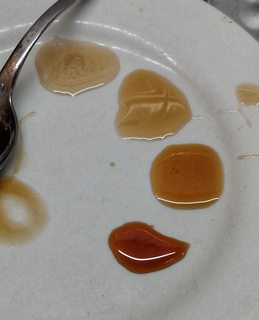peebee
Out of Control
I've carved this off from another thread (Victorian Mild!) to reach out to a larger audience of contributing folk.
"Brewer's Invert" sugar is hard to get (the manufacturer "Ragus" would like you to buy a tonne! Some bakery supplier's will sell it in 25Kg lots). But we are constantly reminded that "Invert Sugar" adds very distinctive flavours to beers, and if trying to clone recipes (mainly older bitter and mild recipes, it is losing popularity in brewing these days) it's essential. Some "milds" in particular relied on it very strongly for flavour and colour. So what can we do?
We can but the stuff from wholesalers, but 25Kg of very sticky block sugar isn't a great addition to house! We can use "alternatives", but household sugars are very different, and Belgium candy sugar/syrup ("candi" if you must) is also very different (see later). It can be made, but it's quite a phaff, especially the darker colours, and there are things to get right or you spend a lot of time making something else! And at a pinch (dream on?) you can "fabricate" it from other ingredients.
To determine what you are after take a look at Ragus's info sheets: IBG-Article-December15.pdf (ragus.co.uk) , a Brewer and Distiller International magazine article from December 2015.
The things to remember is Brewer's Invert Sugar is made from raw cane sugars. But Brewer's Invert Sugar also gains flavours and colour from the heat causing caramelisation and Maillard reactions.
To be continued ...
"Brewer's Invert" sugar is hard to get (the manufacturer "Ragus" would like you to buy a tonne! Some bakery supplier's will sell it in 25Kg lots). But we are constantly reminded that "Invert Sugar" adds very distinctive flavours to beers, and if trying to clone recipes (mainly older bitter and mild recipes, it is losing popularity in brewing these days) it's essential. Some "milds" in particular relied on it very strongly for flavour and colour. So what can we do?
We can but the stuff from wholesalers, but 25Kg of very sticky block sugar isn't a great addition to house! We can use "alternatives", but household sugars are very different, and Belgium candy sugar/syrup ("candi" if you must) is also very different (see later). It can be made, but it's quite a phaff, especially the darker colours, and there are things to get right or you spend a lot of time making something else! And at a pinch (dream on?) you can "fabricate" it from other ingredients.
To determine what you are after take a look at Ragus's info sheets: IBG-Article-December15.pdf (ragus.co.uk) , a Brewer and Distiller International magazine article from December 2015.
The things to remember is Brewer's Invert Sugar is made from raw cane sugars. But Brewer's Invert Sugar also gains flavours and colour from the heat causing caramelisation and Maillard reactions.
To be continued ...




 (actually, white granulated can be used to ease up on the "heaviness" of a beer - some "Belgium" beer recipes might do this). But don't be embarrassed if you did think you can replace Invert Sugar in a recipe with household sugars. I'm going to the trouble of writing this to exorcise those daft ideas out of my head (as I am embarrassed to admit I did have those ideas ... damn, I've just told everyone now!).
(actually, white granulated can be used to ease up on the "heaviness" of a beer - some "Belgium" beer recipes might do this). But don't be embarrassed if you did think you can replace Invert Sugar in a recipe with household sugars. I'm going to the trouble of writing this to exorcise those daft ideas out of my head (as I am embarrassed to admit I did have those ideas ... damn, I've just told everyone now!).




































 for using demerara! I'm not going to say anything that might contradict that later. Which could have caused a rumpus (it's connected to a "Victorian ..." thread, and I like the opportunity to use these words!).
for using demerara! I'm not going to say anything that might contradict that later. Which could have caused a rumpus (it's connected to a "Victorian ..." thread, and I like the opportunity to use these words!).